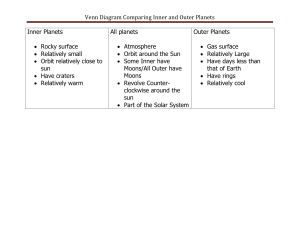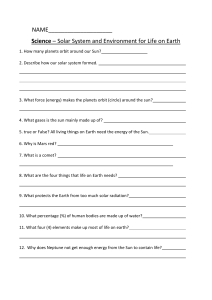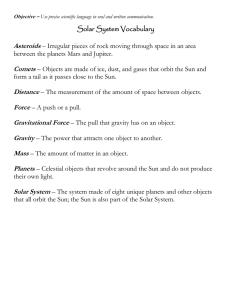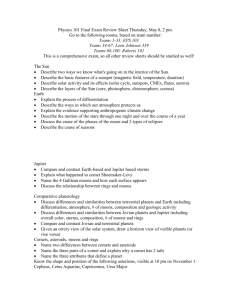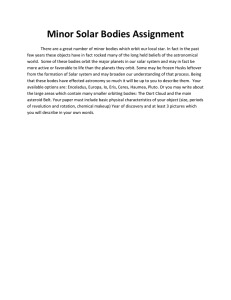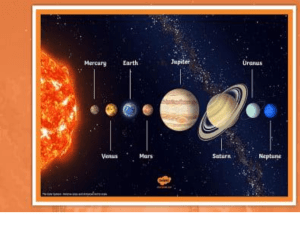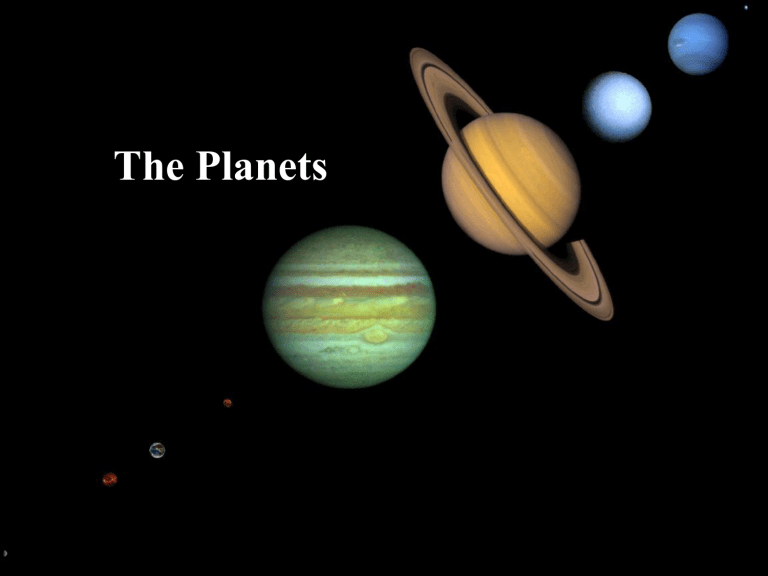
The Planets A. What’s in Our Solar System? • Our solar system consists of a central star (the Sun), planets, dwarf planets, moons, asteroids, comets, meteors, interplanetary gas, dust, and all the “space” in between. • Except for Earth, the planets of the solar system are named for Greek and Roman gods and goddesses. The Relative Size of the Planets in the Solar System B. Planets are categorized according to size and composition – Small, rocky planets are the inner planets closest to the sun – gas giants are the outer planets Inner and Outer Planets • Inner Planets: – Mercury – Venus – Earth – Mars • Outer Planets – Jupiter – Saturn – Uranus – Neptune 1. Characteristics of Inner Planets • • • • • They are made up mostly of rock and metal. They are very heavy. They move slowly in space. They have no rings and few moons (if any). They have a diameter of less than 13,000 km. a. Mercury • Has a revolution period of 88 days. • Has 1000° temperature swings from day to night because there is no atmosphere to trap heat. • Is about 1/3 of Earth’s size • Is about 1/3 Earth’s distance from the sun (0.39 AU) b. Venus • Has retrograde rotation – so the sun rises in the west and sets in the east! • Reaches 900F at the surface due to a strong greenhouse effect. • Venus has no moons and takes 225 days to complete an orbit. • Is about the same size as Earth • Is about 2/3 Earth’s distance from the sun (0.72 AU) c. Earth • Is the only planet known to support life! • Has a surface composed of 71% water. – Water is necessary for life on Earth. • Is the basis for the Astronomical Unit (distance from sun to Earth = 1 AU) d. Mars • Mars appears red because of iron oxide, or rust, in its soil. • Mars has two moons and takes about two years to complete an orbit. • Is about ½ of Earth’s size • Is about 1 ½ times as far from the sun as Earth (1.52 AU) 2. Characteristics of Gas Giants • They are made up mostly of gases (primarily hydrogen & helium). • They are very light for their size. • They move quickly in space. • They have rings and many moons. • They have a diameter of 49,000 km or greater a. Jupiter • Is the largest, most massive planet. • Takes about 12 years to orbit the sun. • Jupiter has 17 known moons. • Is about 11 times larger than Earth. • Is about 5 times farther from the sun than Earth (5.19 AU) b. Saturn • Has many rings made of ice that extend about 260,000 miles from the surface but are less than 1 mile thick. • Has 19 known moons • Takes about 30 years to orbit the sun. • Is almost10 times larger than Earth • Is nearly ten times farther from the sun than Earth (9.5 AU) c. Uranus • Has 21 known moons • Takes 84 years to complete one orbit. • Is about 4 times larger than Earth • Is about 19 times farther from the sun than Earth (19.1 AU) d. Neptune • Takes 165 years to orbit the sun • Has 8 moons • Is about 3.8 times larger than Earth • Is about 30 times farther from the sun than Earth (30 AU)

